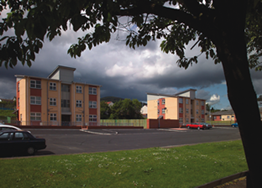European lending for local housing
A relatively recent addition to the social housing landscape in Northern Ireland, the European Investment Bank is increasingly becoming a source of funding for the sector here. Director General of Lending Tom Hackett gives Ryan Jennings an overview of the bank’s work in the province to date.
The European Investment Bank is relatively new to Northern Ireland. Historically its role in housing was limited to just retrofit and reconstruction and not new builds or additions.
Active in Great Britain since 2000, no specific part of the bank’s remit explicitly covers social housing. Since 2007 it has been charged with creating “sustainable cities and communities”, which as Director General Tom Hackett points out, now includes the sector.
While fundamentally the problems social housing faces across Europe are broadly similar according to Hackett, there are notable differences across the states. The status of a borrower, its income-raising ability and its relationship with central government all vary across the 27 member states, so each loan the bank gives is very much tailored to local circumstances.
The Housing Finance Corporation (THFC), Hackett explains, acts as the go-between for the EIB. Should a housing association or local authority make an application to the bank, it is the THFC which will evaluate the proposal on behalf of Hackett’s organisation. In effect THFC can “vouch” for a borrower.
As clients, he explains, UK housing associations’ asset cover is usually very high as housing benefit is paid directly to the associations on behalf of, rather than through, the tenant.
“Part of the income for housing associations is guaranteed, so the bank, like any other bank, can be comfortable with the income source,” he explains.
Unlike the rest of the banking world, the investment bank’s lending in 2009 expanded by 37 per cent, from €58 billion in 2008 to €79 billion. Hackett puts that down to two determining factors: “There were project sponsors coming to us who in fact had never come to us before. We became, I wouldn’t say a lender of last resort, but we were there to provide the long-term capital.
“[And] existing customers increased their requirements or demands because whereas they previously had only been looking for 20 per cent, they were now asking for 35 per cent. So where once we were one of the funding options, we became the leading funding option.”
 Housing associations here, though, do face difficulties getting loans from the bank. By and large, the project cost should be a minimum of £50 million for the EIB to consider lending, but very rarely would an association in Northern Ireland be seeking that amount.
Housing associations here, though, do face difficulties getting loans from the bank. By and large, the project cost should be a minimum of £50 million for the EIB to consider lending, but very rarely would an association in Northern Ireland be seeking that amount.
“We take a fairly loose definition of what a project can be,” Hackett explains. “It can be a group of individual sub-projects so that if one can find three to four housing associations [which] individually are looking for £10 [million] or £12 million, that could make up the £50 million and justify the loan.”
Likewise, he is quick to point out that if there was a project put to the bank that was worth only £20 million but had “significant advantages”, it would not automatically dismiss it, especially in an area of “particular need”, such as Northern Ireland.
As the bank’s policy is to look predominantly at urban housing, its work is very much greater Belfast-centric. Within the city’s wider confines, there have been 14 developments across six housing associations as opposed to Derry’s two.
Comparing some rural parts of Northern Ireland to the Shetland Islands, from which they have also received applications for schemes, the Director General comments: “If we were looking at a project in [for example] Derry, we would be a little hard pushed if it was purely a rural scheme.”
There are three added criteria to take into account when assessing loan applications. Not only does the quality of the project need to be taken into account, but also its “social usefulness”, the quality of the housing association’s management and its track record.
In addition, environmental impacts are becoming increasingly important and indeed are playing a more significant role in the EIB’s Joint European Support for Sustainable Investment in City Areas (Jessica programme). Housing is not eligible for that funding, but Hackett contends that money spent from that pot on roads and public transport infrastructure does have an impact on housing because areas can become more desirable when they are better connected.
Having had the opportunity to survey the social housing sector across the EU, it would be remiss not to seek his opinion on the sector here.
That there are 36 registered housing associations on Northern Ireland troubles Hackett. Instead, he advocates significant consolidation between the associations: “I wouldn’t go as far as having a Northern Ireland housing association but two or three need to come together as one.”
Although he admits the sector is a very active one, he suggests that it needs a more supervising authority: “It clearly needs consolidation. The drawback is that you lose a tie with the local communities, which is obviously one of the strengths of housing associations in Northern Ireland.
Alternatively, they could work on “pooled services” and retain their separate identities. But from the EIB’s point of view “some sort of consolidation could be of benefit.”
With a AAA credit rating and a conservative approach to risk management, the bank itself is entirely a public organisation – one of the few purposefully public banks remaining, Tom Hackett jokes.
As a public bank, he suggests, it does not make ‘profits’ in the traditional sense, rather they finish the year with a ‘surplus’, indeed last year that amounted to €1.9 billion. Summing up the bank’s role, he says: “Our focus is to try and ensure that good quality investment projects are taken forward and aren’t held back because they can’t find adequate finances.”
Another route?
As agendaNi reported in March, Northern Ireland is now eligible to apply for the housing grants offered by the European Regional Development Fund, though that money is officially set aside for “marginalised” communities.






